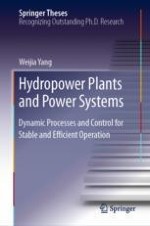2019 | Buch
Über dieses Buch
This book reports on a comprehensive study addressing the dynamic responses of hydropower plants under diverse conditions and disturbances, and analyzes their stability and oscillations. Multiple models based on eight existing hydropower plants in Sweden and China were developed and used for simulations and theoretical analysis with various degrees of complexity and for different purposes, and compared with on-site measurements for validations. The book offers important insights into the understanding of the hydraulic, mechanical and electrical coupling mechanisms, up to market conditions and incentives. It recommends control strategies for a more stable and efficient operation of hydropower plants.
Anzeige
